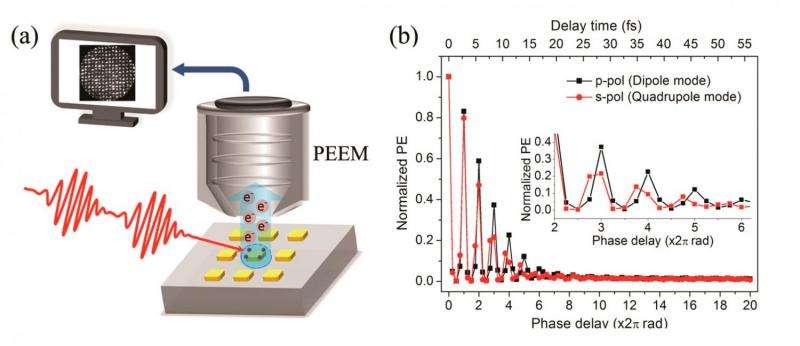Two different collective oscillations of electrons occurring on gold nanoparticles observed for the first time

The research group of Professor Hiroaki Misawa of Research Institute for Electronic Science, Hokkaido University and Assistant Professor Atsushi Kubo of the Faculty of Pure and Applied Sciences, University of Tsukuba, have successfully observed the dephasing time of the two different types of collective motions of electrons generated on the surface of a gold nanoparticle for the first time in the world, by combining a laser that emits ultrashort light pulses with a photoemission electron microscope.
When gold is reduced to the size in nanometer scale, its color is red instead of gold. When gold nanoparticles are exposed to light, the collective oscillations of electrons existing on the localized surface of the gold causes red light to be strongly absorbed and dispersed.
This phenomenon is called Surface Plasmon Resonance. The red color of stained glass is also a result of this phenomenon. Recently, gold nanoparticles have been widely used in various fields, such as application in pregnancy tests.
This collective oscillations of electrons on the surface of gold nanoparticles caused by light was considered to be a phenomenon that sustained only for an extremely short time, and difficult to measure due to this shortness.
Our research group developed a methodology to measure the dephasing time of the collective oscillations of electrons occurring on the surface of gold nanoparticles by combining a laser that emits ultrashort light pulses of a few femtoseconds (1 femtosecond = 10-15 seconds), and a photoemission electron microscope in high spatial resolution.
When measured by this technique, the different dephasing times of the two different collective oscillations, namely dipole and quadrupole surface plasmon modes, could be resolved and identified as 5 femtoseconds and 9 femtoseconds, respectively.
Research using gold nanoparticles as optical antennae to harvest light for photovoltaic cell and an artificial photosynthesis system that can split water to obtain hydrogen is progressing. The successful measurement of the dephasing time of the collective oscillations of electrons is considered to be a useful guideline in developing these systems.
More information: Quan Sun et al. Dissecting the Few-Femtosecond Dephasing Time of Dipole and Quadrupole Modes in Gold Nanoparticles Using Polarized Photoemission Electron Microscopy, ACS Nano (2016).
Journal information: ACS Nano
Provided by Hokkaido University





















